外研版(2019)必修第三册 Unit 3 The world of science Using language课件(共23张PPT)
文档属性
| 名称 | 外研版(2019)必修第三册 Unit 3 The world of science Using language课件(共23张PPT) | 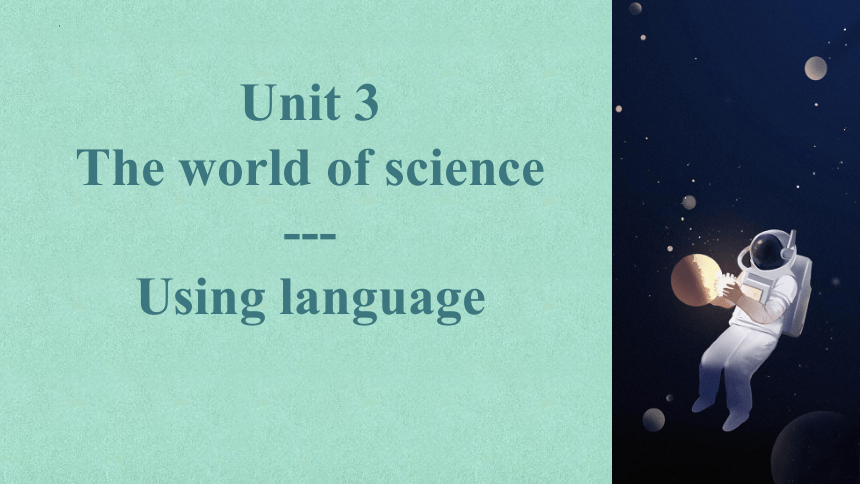 | |
| 格式 | pptx | ||
| 文件大小 | 2.7MB | ||
| 资源类型 | 教案 | ||
| 版本资源 | 外研版(2019) | ||
| 科目 | 英语 | ||
| 更新时间 | 2023-03-26 22:07:53 | ||
图片预览

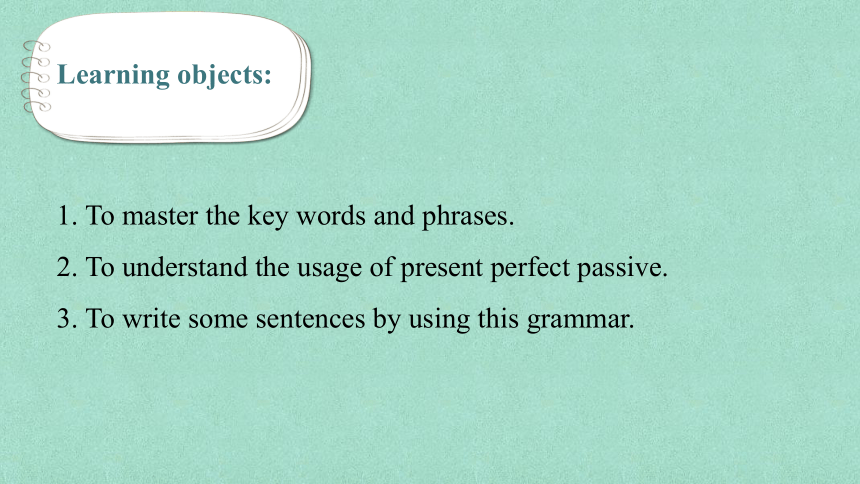
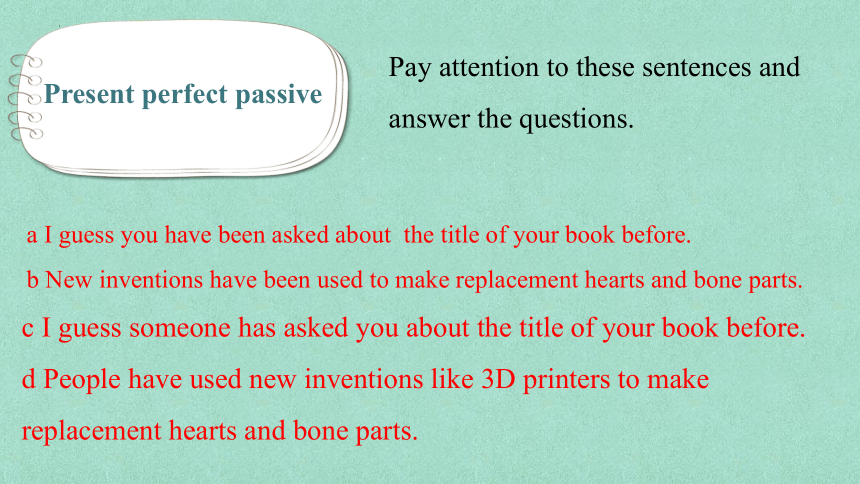
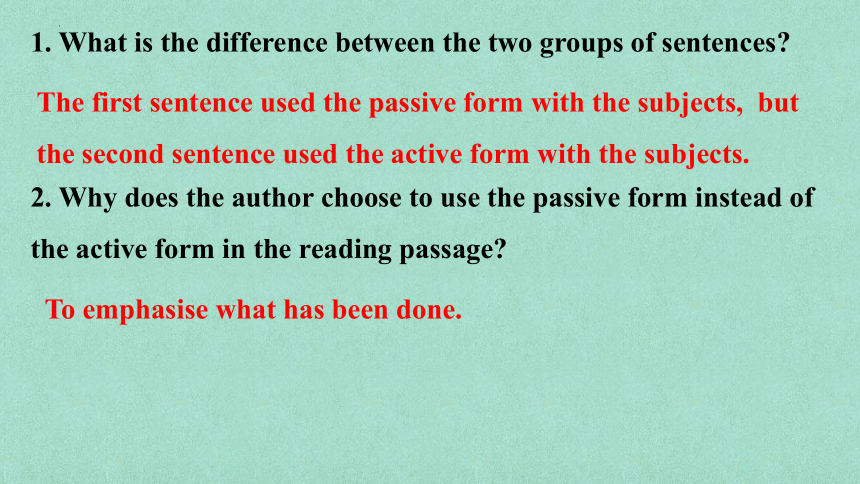
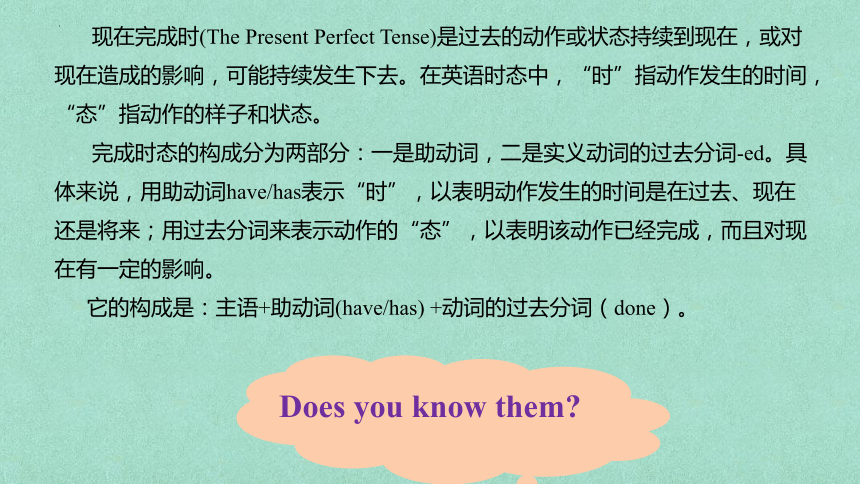
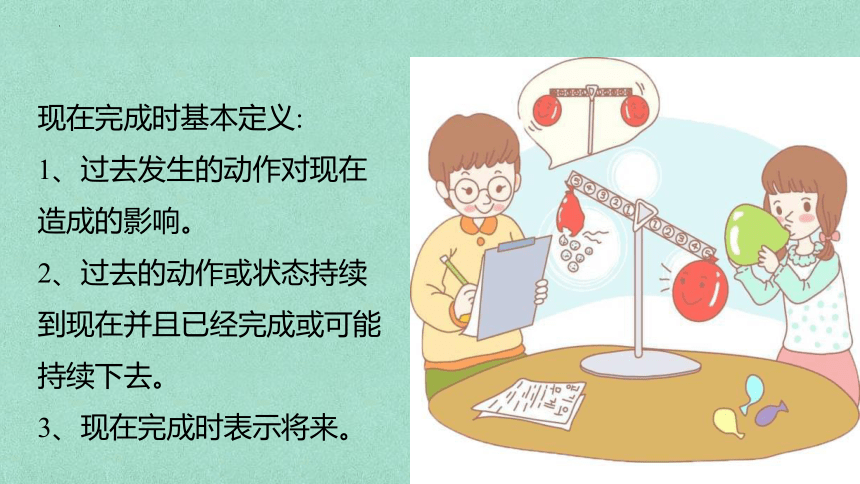
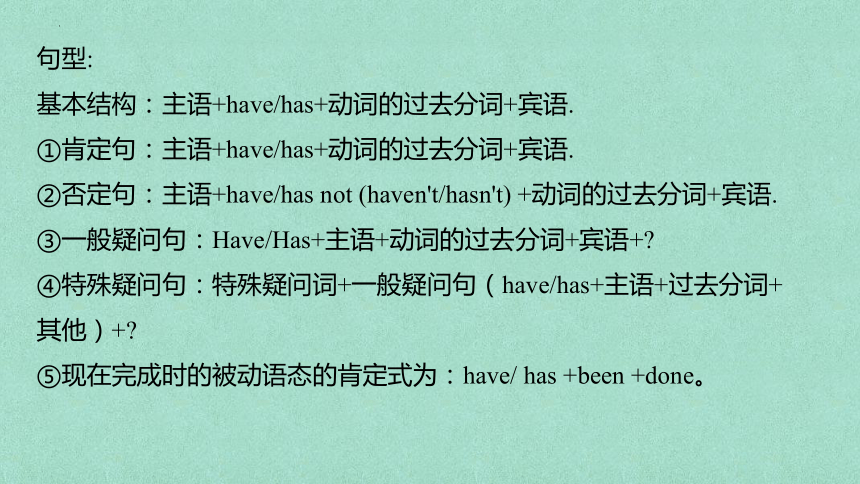
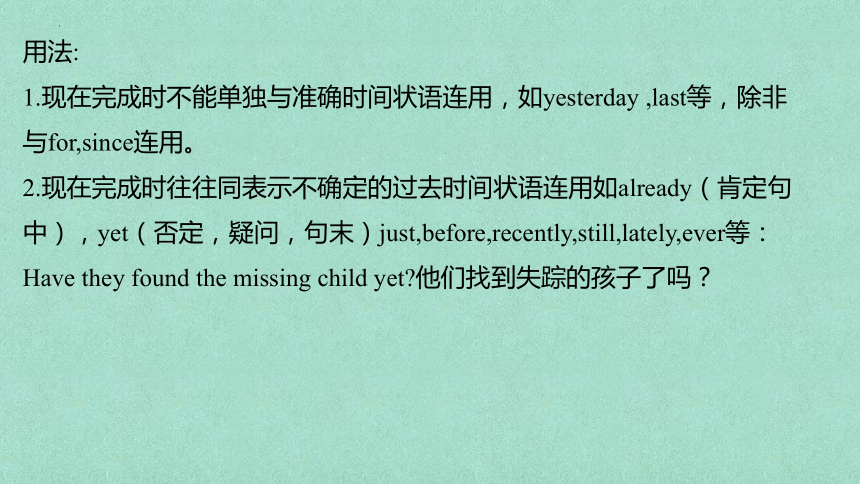
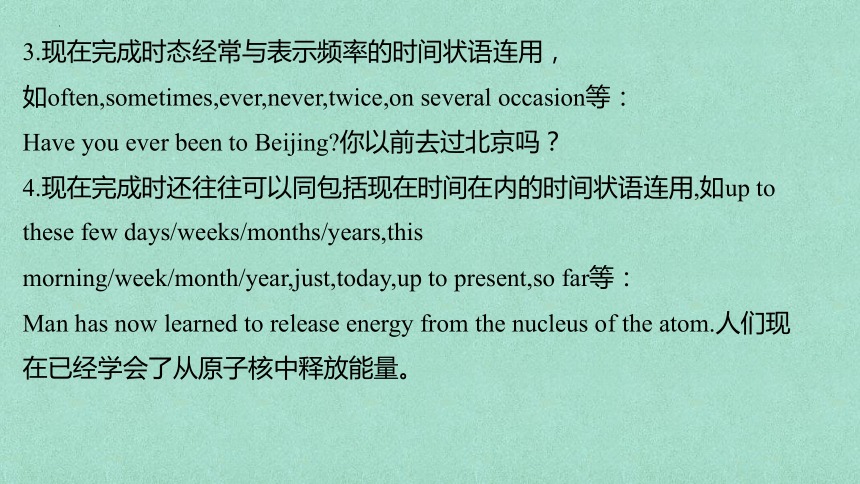
文档简介
(共23张PPT)
Unit 3
The world of science
---
Using language
Learning objects:
1. To master the key words and phrases.
2. To understand the usage of present perfect passive.
3. To write some sentences by using this grammar.
Present perfect passive
Pay attention to these sentences and answer the questions.
c I guess someone has asked you about the title of your book before.
d People have used new inventions like 3D printers to make replacement hearts and bone parts.
a I guess you have been asked about the title of your book before.
b New inventions have been used to make replacement hearts and bone parts.
1. What is the difference between the two groups of sentences
2. Why does the author choose to use the passive form instead of the active form in the reading passage
The first sentence used the passive form with the subjects, but the second sentence used the active form with the subjects.
To emphasise what has been done.
Does you know them
现在完成时(The Present Perfect Tense)是过去的动作或状态持续到现在,或对现在造成的影响,可能持续发生下去。在英语时态中,“时”指动作发生的时间,“态”指动作的样子和状态。
完成时态的构成分为两部分:一是助动词,二是实义动词的过去分词-ed。具体来说,用助动词have/has表示“时”,以表明动作发生的时间是在过去、现在还是将来;用过去分词来表示动作的“态”,以表明该动作已经完成,而且对现在有一定的影响。
它的构成是:主语+助动词(have/has) +动词的过去分词(done)。
现在完成时基本定义:
1、过去发生的动作对现在造成的影响。
2、过去的动作或状态持续到现在并且已经完成或可能持续下去。
3、现在完成时表示将来。
句型:
基本结构:主语+have/has+动词的过去分词+宾语.
①肯定句:主语+have/has+动词的过去分词+宾语.
②否定句:主语+have/has not (haven't/hasn't) +动词的过去分词+宾语.
③一般疑问句:Have/Has+主语+动词的过去分词+宾语+
④特殊疑问句:特殊疑问词+一般疑问句(have/has+主语+过去分词+其他)+
⑤现在完成时的被动语态的肯定式为:have/ has +been +done。
用法:
1.现在完成时不能单独与准确时间状语连用,如yesterday ,last等,除非与for,since连用。
2.现在完成时往往同表示不确定的过去时间状语连用如already(肯定句中),yet(否定,疑问,句末)just,before,recently,still,lately,ever等:
Have they found the missing child yet 他们找到失踪的孩子了吗?
3.现在完成时态经常与表示频率的时间状语连用,
如often,sometimes,ever,never,twice,on several occasion等:
Have you ever been to Beijing 你以前去过北京吗?
4.现在完成时还往往可以同包括现在时间在内的时间状语连用,如up to these few days/weeks/months/years,this morning/week/month/year,just,today,up to present,so far等:
Man has now learned to release energy from the nucleus of the atom.人们现在已经学会了从原子核中释放能量。
5.现在完成时还可以用来表示过去的一个时间到现在这段时间内重复发生的动作.
6.现在完成时的"完成用法"指的是动作发生在过去某一时刻并已结束。例如:He has turned the light off .他已把灯关了。
7.现在完成时的"未完成用法"指的是动作开始于过去某一时刻,一直延续到现在,或可能还要继续下去。
例如:He has lived here since 1978.自从1978年以来,他一直住在这儿。(动作起始于1978年,一直住到现在,可能还要继续住下去。)
I have been in the army for more than 5 years.我在部队已经呆了五年多了。(动作开始于5年前,一直延续至今,有可能还要继续下去。)
此种用法的句中常需一个表示一段时间的状语(由since或for引导),或表示与现在时刻相连的时间状语(如:up to now,so far)等。
例如:I have heard nothing from him up to now.到目前为止我没有他的任何消息。
注意:(1)现在完成时的未完成用法只适用于延续性动词,不可用于终止性动词,即瞬间完成或延续时间很短的动词。如:come,go,arrive,leave,join,become,die等。
8.一段时间+has passed+since从句。
9.现在完成时常用短语 "up to now /till now","so far" (意思是从过去某一确定的时间一直延续到现在)连用。
Up to/till now he's read many story books. 至今他已读过好多故事书。
I've been to New York three times so far. 至今我已到纽约去过三次。
has gone (to),has been (to),has been (in) 的区别。
has gone to:表示某人已去了某地,而没有回来(去了没回)(不可与 for+一段时间 连用)
has been to :表示去过某地(去过已回来)(不可与 for+一段时间 连用)
has been in/at(in表示相对大一些的地点;at表示相对小一些的地点):表示一直呆在某地, 常与时间段搭配(呆了很久)。
10.不可以与一般过去时的定义混淆
用动词的正确形式填空。
1. The same toys _______________ (make) in this factory.
2. 100 facts ________________ (show) in this report.
3. Tom wanted a book but ________ (give) a book by his parents.
4. Although it _______________ (play) many times, he still can not understand it.
5. Three new schools _______________ (open) in our city.
have been made
have been shown
was given
has been played
have been opened
Careers in science
Look at the pictures and answer the questions.
Guo Shoujing (1231–1316) was a famous Chinese
1____________ of the Yuan Dynasty. He invented twelve
new instruments to study stars and planets. He also
developed a calendar which is as accurate as the Gregorian
calendar. A mountain on the Moon and a minor planet are
named after him
astronomer
British 2____________ Charles Darwin (1809–1882) is best
known for his work On the Origin of Species, in which he
explains changes in species due to natural selection. His
ideas deeply influence our understanding of the relationship
between humans and nature.
biologist
Li Daoyuan (ca 466–527) was a famous writer and
3____________ of the Northern Wei Dynasty. He did field
research across China and studied more than a thousand
rivers and streams, along with the landscape, history and
culture of the surrounding areas.
geographer
Marie Curie (1867–1934) was a world-famous 4___________, and was first awarded the Nobel Prize in 1903 for her extraordinary work on radioactivity. She was also regarded as a brilliant 5____________, and was again awarded the Nobel Prize in 1911 for the isolation of pure radium.
chemist
physicist
Chen Jingrun (1933–1996) was one of the world’s leading
6____________. His work on Chen’s Theorem made an
important advance towards proving Goldbach’s Conjecture,
the greatest unsolved problem in number theory.
mathematician
Thank you
Unit 3
The world of science
---
Using language
Learning objects:
1. To master the key words and phrases.
2. To understand the usage of present perfect passive.
3. To write some sentences by using this grammar.
Present perfect passive
Pay attention to these sentences and answer the questions.
c I guess someone has asked you about the title of your book before.
d People have used new inventions like 3D printers to make replacement hearts and bone parts.
a I guess you have been asked about the title of your book before.
b New inventions have been used to make replacement hearts and bone parts.
1. What is the difference between the two groups of sentences
2. Why does the author choose to use the passive form instead of the active form in the reading passage
The first sentence used the passive form with the subjects, but the second sentence used the active form with the subjects.
To emphasise what has been done.
Does you know them
现在完成时(The Present Perfect Tense)是过去的动作或状态持续到现在,或对现在造成的影响,可能持续发生下去。在英语时态中,“时”指动作发生的时间,“态”指动作的样子和状态。
完成时态的构成分为两部分:一是助动词,二是实义动词的过去分词-ed。具体来说,用助动词have/has表示“时”,以表明动作发生的时间是在过去、现在还是将来;用过去分词来表示动作的“态”,以表明该动作已经完成,而且对现在有一定的影响。
它的构成是:主语+助动词(have/has) +动词的过去分词(done)。
现在完成时基本定义:
1、过去发生的动作对现在造成的影响。
2、过去的动作或状态持续到现在并且已经完成或可能持续下去。
3、现在完成时表示将来。
句型:
基本结构:主语+have/has+动词的过去分词+宾语.
①肯定句:主语+have/has+动词的过去分词+宾语.
②否定句:主语+have/has not (haven't/hasn't) +动词的过去分词+宾语.
③一般疑问句:Have/Has+主语+动词的过去分词+宾语+
④特殊疑问句:特殊疑问词+一般疑问句(have/has+主语+过去分词+其他)+
⑤现在完成时的被动语态的肯定式为:have/ has +been +done。
用法:
1.现在完成时不能单独与准确时间状语连用,如yesterday ,last等,除非与for,since连用。
2.现在完成时往往同表示不确定的过去时间状语连用如already(肯定句中),yet(否定,疑问,句末)just,before,recently,still,lately,ever等:
Have they found the missing child yet 他们找到失踪的孩子了吗?
3.现在完成时态经常与表示频率的时间状语连用,
如often,sometimes,ever,never,twice,on several occasion等:
Have you ever been to Beijing 你以前去过北京吗?
4.现在完成时还往往可以同包括现在时间在内的时间状语连用,如up to these few days/weeks/months/years,this morning/week/month/year,just,today,up to present,so far等:
Man has now learned to release energy from the nucleus of the atom.人们现在已经学会了从原子核中释放能量。
5.现在完成时还可以用来表示过去的一个时间到现在这段时间内重复发生的动作.
6.现在完成时的"完成用法"指的是动作发生在过去某一时刻并已结束。例如:He has turned the light off .他已把灯关了。
7.现在完成时的"未完成用法"指的是动作开始于过去某一时刻,一直延续到现在,或可能还要继续下去。
例如:He has lived here since 1978.自从1978年以来,他一直住在这儿。(动作起始于1978年,一直住到现在,可能还要继续住下去。)
I have been in the army for more than 5 years.我在部队已经呆了五年多了。(动作开始于5年前,一直延续至今,有可能还要继续下去。)
此种用法的句中常需一个表示一段时间的状语(由since或for引导),或表示与现在时刻相连的时间状语(如:up to now,so far)等。
例如:I have heard nothing from him up to now.到目前为止我没有他的任何消息。
注意:(1)现在完成时的未完成用法只适用于延续性动词,不可用于终止性动词,即瞬间完成或延续时间很短的动词。如:come,go,arrive,leave,join,become,die等。
8.一段时间+has passed+since从句。
9.现在完成时常用短语 "up to now /till now","so far" (意思是从过去某一确定的时间一直延续到现在)连用。
Up to/till now he's read many story books. 至今他已读过好多故事书。
I've been to New York three times so far. 至今我已到纽约去过三次。
has gone (to),has been (to),has been (in) 的区别。
has gone to:表示某人已去了某地,而没有回来(去了没回)(不可与 for+一段时间 连用)
has been to :表示去过某地(去过已回来)(不可与 for+一段时间 连用)
has been in/at(in表示相对大一些的地点;at表示相对小一些的地点):表示一直呆在某地, 常与时间段搭配(呆了很久)。
10.不可以与一般过去时的定义混淆
用动词的正确形式填空。
1. The same toys _______________ (make) in this factory.
2. 100 facts ________________ (show) in this report.
3. Tom wanted a book but ________ (give) a book by his parents.
4. Although it _______________ (play) many times, he still can not understand it.
5. Three new schools _______________ (open) in our city.
have been made
have been shown
was given
has been played
have been opened
Careers in science
Look at the pictures and answer the questions.
Guo Shoujing (1231–1316) was a famous Chinese
1____________ of the Yuan Dynasty. He invented twelve
new instruments to study stars and planets. He also
developed a calendar which is as accurate as the Gregorian
calendar. A mountain on the Moon and a minor planet are
named after him
astronomer
British 2____________ Charles Darwin (1809–1882) is best
known for his work On the Origin of Species, in which he
explains changes in species due to natural selection. His
ideas deeply influence our understanding of the relationship
between humans and nature.
biologist
Li Daoyuan (ca 466–527) was a famous writer and
3____________ of the Northern Wei Dynasty. He did field
research across China and studied more than a thousand
rivers and streams, along with the landscape, history and
culture of the surrounding areas.
geographer
Marie Curie (1867–1934) was a world-famous 4___________, and was first awarded the Nobel Prize in 1903 for her extraordinary work on radioactivity. She was also regarded as a brilliant 5____________, and was again awarded the Nobel Prize in 1911 for the isolation of pure radium.
chemist
physicist
Chen Jingrun (1933–1996) was one of the world’s leading
6____________. His work on Chen’s Theorem made an
important advance towards proving Goldbach’s Conjecture,
the greatest unsolved problem in number theory.
mathematician
Thank you
